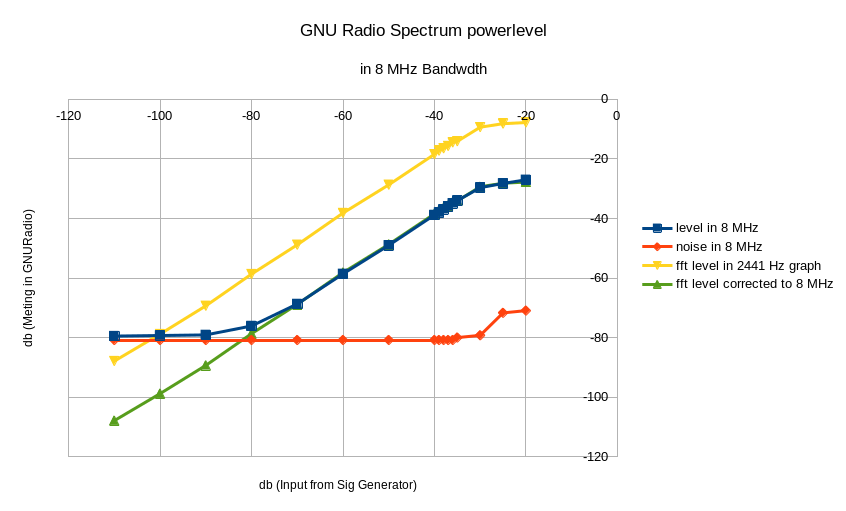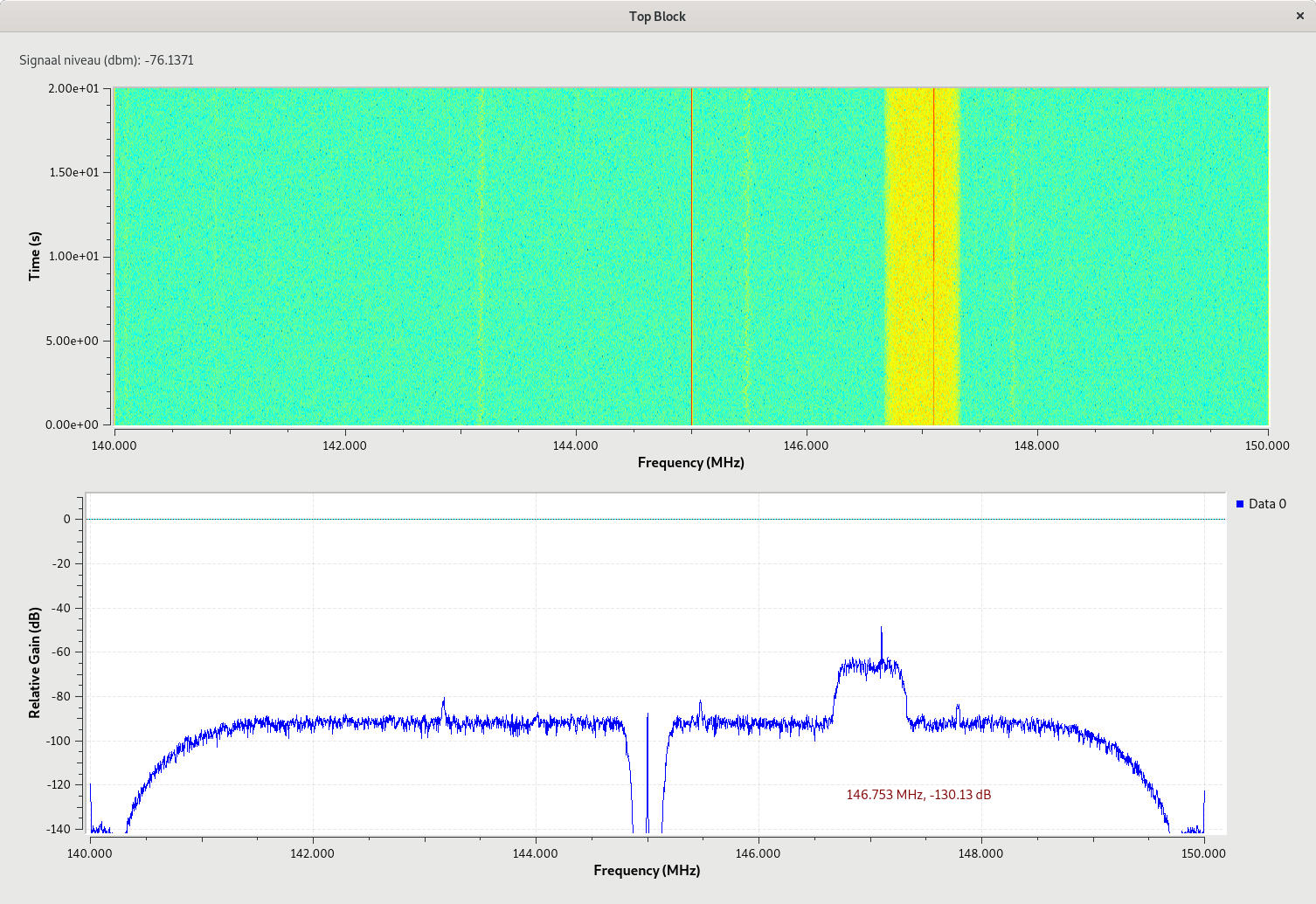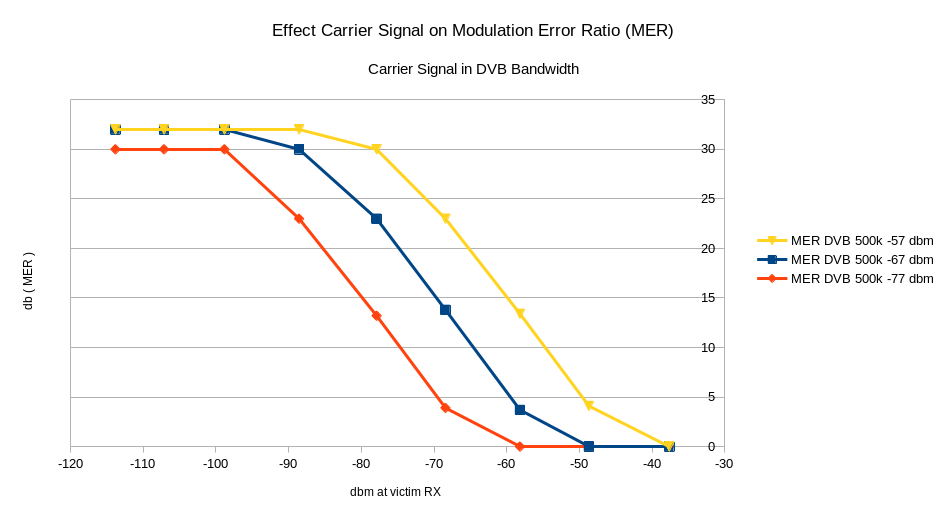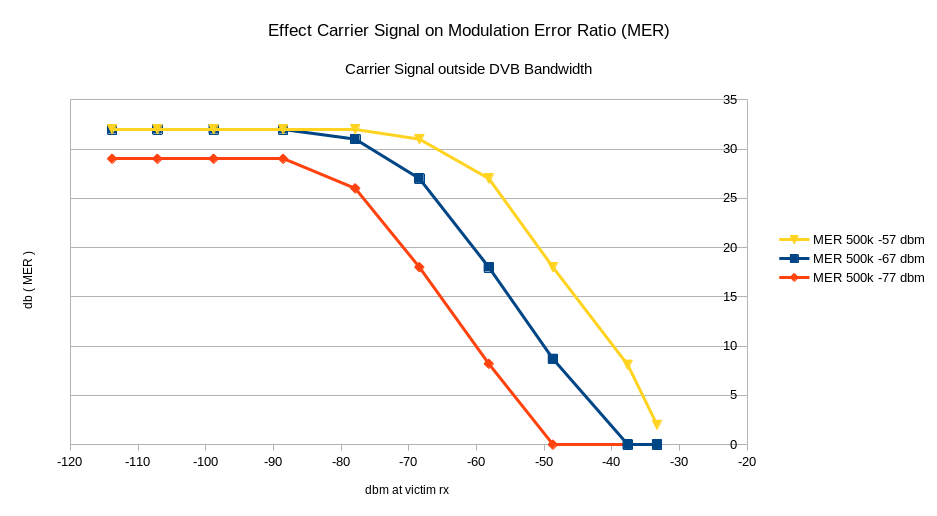DATV and Interfering signals
(2020-03-05) PE1ITR
I was curious to what extent our DATV signals on the VHF bands are resistant to other signals. Specifically, the question was how strong an interfering signal may be at the receiver before the DATV can no longer be demodulated.
This is interesting because of the datv experiments that I perform on the 6m band and the reasonable chance that there will also be interfering other signals. However, the outcome can also be applied to other situations.
I made a test setup according to the block diagram below. A DATV signal with DVB-S2 500k FEC 2/3 modulation is received with certain signal levels. A Carrier Signal is also offered to the same receiver. The level of the carrier signal is gradually made stronger. We looked at the effect of this situation on demodulation in the DVB receiver. Two situations are simulated. A signal within the bandwidth of the DVB signal. And secondly a signal just outside the bandwidth of the DVB signal.

Signal Power Levels
The signal levels are measured with an SDR receiver in combination with GNU Radio. The spectrum analyzer in the block diagram is in fact an SDR receiver. A HackRF was used as the SDR receiver.
The setup within GNU Radio is described here. It is important to determine that the signal level remains within the dynamic range of the receiver.
The graph below shows that a signal to the receiver. The level in dBm of the signal from signal generator is on the horizontal axis. On the vertical axis, the level measured in GNU Radio. Measurement is carried out in two ways. The blue line is the measured level in 8 MHz bandwidth from the Magnitude block in GNU Radio. The level was also measured in the FFT screen as a check, represented by the yellow line. Because the FFTs on the FFT screen have a small bandwidth and therefore less noise power, a little 'further' can be looked into the noise. As a check, the yellow line has been calculated back to the green line. The green line almost coincides with the blue line.
The HackRF falls into saturation at -30 dBm, so we have to stay below that.

Modulation Error Ratio
With a QPSK signal, a constellation of 4 points is formed. Each point represents a number of bits. For a QPSK signal, this is 00, 01, 10 and 11. The vector pointing to the point jumps to a next quadrant depending on the bit stream to be transmitted.
If these IQ points do not appear at the desired points due to interference, noise, jitter, etc., then there is a modulation error. A method for measuring the extent of these errors is the MER, Modulation Error Ratio.
MER in db = 10 * log10( average symbol power / average error power)
The DVB receiver shows the MER value. With a very low MER, the receiver no longer demodulates and the signal drops out. It is digital television and that moment of no signal is abrupt.
Effect of the interference level on the MER
The minitiouner recever is used. This receiver works from 144 MHz to 2400 MHz. For practical reasons, the measurements were performed at 145 MHz. In this measurement we speak of interference if the MER value falls due to the carrier signal. It is not problematic when the MER value falls, but the receiver can still decode. It is problematic when the decoder can no longer process it and the picture is lost.
In band interference
In this situation, a carrier signal is added on top of the DVB signal.

The graph below shows that the MER value is started te be influenced when the carrier signal is -20 db or less below the level of DVB signal. The DVB receiver stops working and the television image is lost when the carrier is +5db compared to the DVB signal.

Interference on the edge of the DVB signal
In this situation, a carrier signal is added to the edge of the DVB signal. When the distance from the center to the edge of the DVB signal is 100%, the interfering carrier signal is at 100.1%.

The graph shows that the MER value is started te be influenced when the carrier signal is -10 db or less below the level of DVB signal. The DVB receiver stops working and the television image is lost when the carrier is +25db compared to the DVB signal. The conclusion is that interference at the edge of the DVB signal and even further away has less influence.

HOME | Go Back





